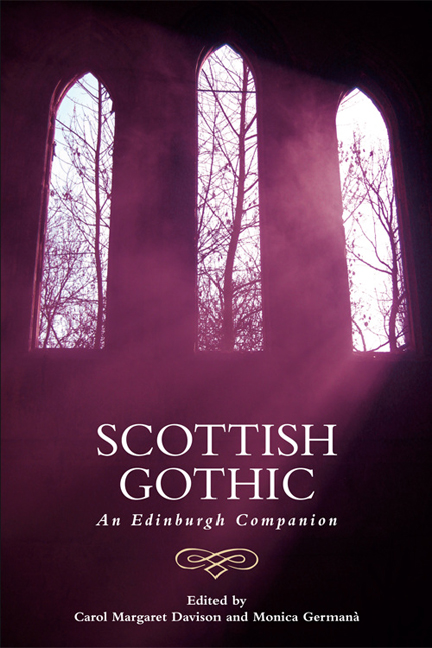Book contents
- Frontmatter
- Contents
- Acknowledgements
- 1 Borderlands of Identity and the Aesthetics of Disjuncture: An Introduction to Scottish Gothic
- 2 ‘The Celtic Century’ and the Genesis of Scottish Gothic
- 3 The Politics and Poetics of the ‘Scottish Gothic’ from Ossian to Otranto and Beyond
- 4 Robert Burns and the Scottish Bawdy Politic
- 5 Scottish Gothic Drama
- 6 Scottish Gothic Poetry
- 7 Calvinist and Covenanter Gothic
- 8 Gothic Scott
- 9 Gothic Hogg
- 10 ‘The Singular Wrought Out into the Strange and Mystical’: Blackwood's Edinburgh Magazine and the Transformation of Terror
- 11 Gothic Stevenson
- 12 J. M. Barrie's Gothic: Ghosts, Fairy Tales and Lost Children
- 13 The ‘nouveau frisson’: Muriel Spark's Gothic Fiction
- 14 Scottish Gothic and the Moving Image: A Tale of Two Traditions
- 15 New Frankensteins; or, the Body Politic
- 16 Queer Scottish Gothic
- 17 Authorship, ‘Ghost-filled’ Islands and the Haunting Feminine: Contemporary Scottish Female Gothic
- Notes on Contributors
- Index
9 - Gothic Hogg
Published online by Cambridge University Press: 20 December 2017
- Frontmatter
- Contents
- Acknowledgements
- 1 Borderlands of Identity and the Aesthetics of Disjuncture: An Introduction to Scottish Gothic
- 2 ‘The Celtic Century’ and the Genesis of Scottish Gothic
- 3 The Politics and Poetics of the ‘Scottish Gothic’ from Ossian to Otranto and Beyond
- 4 Robert Burns and the Scottish Bawdy Politic
- 5 Scottish Gothic Drama
- 6 Scottish Gothic Poetry
- 7 Calvinist and Covenanter Gothic
- 8 Gothic Scott
- 9 Gothic Hogg
- 10 ‘The Singular Wrought Out into the Strange and Mystical’: Blackwood's Edinburgh Magazine and the Transformation of Terror
- 11 Gothic Stevenson
- 12 J. M. Barrie's Gothic: Ghosts, Fairy Tales and Lost Children
- 13 The ‘nouveau frisson’: Muriel Spark's Gothic Fiction
- 14 Scottish Gothic and the Moving Image: A Tale of Two Traditions
- 15 New Frankensteins; or, the Body Politic
- 16 Queer Scottish Gothic
- 17 Authorship, ‘Ghost-filled’ Islands and the Haunting Feminine: Contemporary Scottish Female Gothic
- Notes on Contributors
- Index
Summary
As Angela Wright has noted, in Scottish Gothic literature, graves and manuscripts are ‘warmly contested sites of authenticity and authority’ (2007: 76). The burial ground excavated at the end of James Hogg's The Private Memoirs and Confessions of a Justified Sinner (1824) is just such a contested memorial: the grave that harbours an uncanny tale of religious fundamentalism, or diabolical possession, does not readily give up its secrets. Robert Wringhim's corpse preserves a manuscript whose provenance, and legacy, cannot be determined. The exhumed body releases its enigmatic text into circulation, and this final resting place becomes an opening to future readings. In his antiquarian or archaeological – and thus typically Gothic – effort to authenticate Wringhim's memoir, the Editor's narrative draws on ‘history, justiciary records, and tradition’ (Hogg 2002c: 64) to frame the ‘singular’ document whose ‘drift’ (2002c: 174) he cannot comprehend. Yet the ‘sequel’ to these narratives (it is actually a beginning) returns us to Hogg's home territory of the Borders. The field trip to Wringhim's grave is prompted by a letter published in Blackwood's from ‘James Hogg’, concerning the excavation of the corpse of a suicide discovered in a miraculous state of preservation. Keen to examine these ‘wonderful remains personally’, the Editor tracks down Hogg at the ewe fair in Thirlestane, but the taciturn Shepherd has no interest in exhuming this ‘Scots mummy’: ‘I hair mair ado than I can manage the day, foreby ganging to houk up hunderyear- auld bones’ (2002c: 170). Hogg refuses the role of Wordsworthian ‘rustic’ (Pope 1992: 223), eager to tell the story of the bones to a stranger (which is, precisely, ironically, what the ‘real’ James Hogg is doing). The Shepherd's letter has initially triggered the Editor's curiosity, but it warns against further disturbance of the grave, which will cause the flesh to ‘fall to dust’ (Hogg 2002c: 169). His resistance to the enterprise may suggest guilt at exposing old bones to the modern gaze, but equally the desire to see the found text trouble and perplex the enlightened reader. This ambivalent encounter between urban modernity and rural tradition, and the failure to establish an agreed account of the Scottish past and present, exemplify Hogg's brand of Gothic.
- Type
- Chapter
- Information
- Scottish GothicAn Edinburgh Companion, pp. 115 - 128Publisher: Edinburgh University PressPrint publication year: 2017

